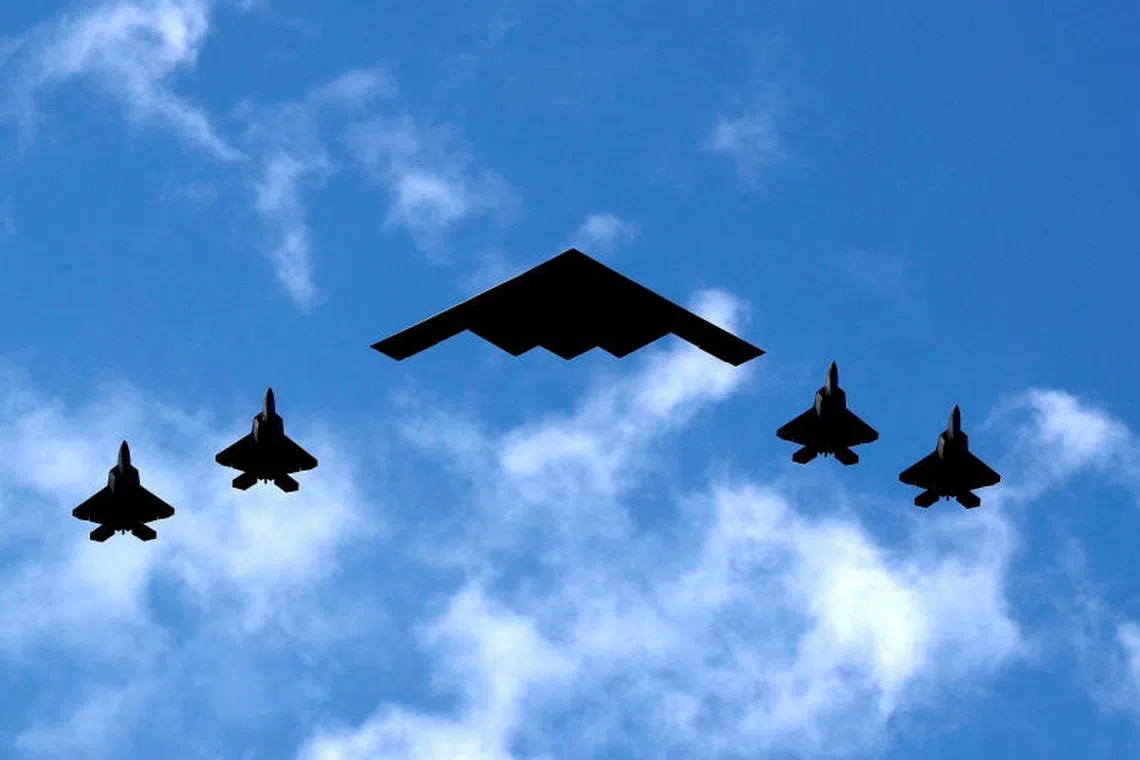US bombing of Iran’s nuclear sites started with a fake-out
Sign up now: Get ST's newsletters delivered to your inbox

A US Air Force B-2 Spirit Stealth Bomber (centre) flanked by four F-22 Raptor fighter planes during a flyover in New York in 2020.
PHOTO: REUTERS
Follow topic:
WASHINGTON - As Operation Midnight Hammer got underway on June 21, a group of B-2 bombers took off from their base in the US state of Missouri and were noticed heading out toward the Pacific island of Guam, in what experts saw as possible pre-positioning for any US decision to strike Iran.
But they were a decoy. The real group of seven bat-winged, B-2 stealth bombers flew east undetected for 18 hours, keeping communications to a minimum, refueling in mid-air, the US military revealed on June 22.
As the bombers neared Iranian airspace, a US submarine launched more than two dozen Tomahawk land attack cruise missiles. US fighter jets flew as decoys in front of the bombers to sweep for any Iranian fighter jets and missiles.
The attack on Iran’s three main nuclear sites was the largest operational strike ever
The B-2 bombers dropped 14 bunker-busting GBU-57 Massive Ordnance Penetrators, each weighing over 13,600kg. The operation involved over 125 US military aircraft, according to the Pentagon.
From the US military’s perspective, the operation was a resounding tactical success. The Iranians were unable to get off a single round at the American aircraft and were caught completely flat-footed, General Dan Caine, the chairman of the Joint Chiefs of Staff, told reporters at the Pentagon on June 22.
“Iran’s fighters did not fly, and it appears that Iran’s surface to air missile systems did not see us throughout the mission,” Gen Caine said. “We retained the element of surprise.”

Gen Caine said initial battle damage assessments indicated that all three sites targeted sustained extremely severe damage and destruction, but he declined to speculate whether any Iranian nuclear capabilities might still be intact.
US Defence Secretary Pete Hegseth was more confident.
“It was clear we devastated the Iranian nuclear programme,” he said, standing alongside Gen Caine in the Pentagon briefing room.
Midnight Hammer was highly classified, Gen Caine said, “with very few people in Washington knowing the timing or nature of the plan.” Many senior officials in the United States only learned of it on the night of June 21 from President Donald Trump’s first post on social media.
Mr Hegseth said it took months of preparations to ensure the US military would be ready if Mr Trump ordered the strikes. Gen Caine said the mission itself, however, came together in just a matter of weeks.
What happens next is unclear.
Gulf states, home to multiple US military bases, were on high alert on June 22 as they weighed the risks of a widening conflict in the region.
Guarding against blowback, the US military also dispersed US military assets in the Middle East and heightened force protection for US troops.
Mr Hegseth said the US military was positioned to defend itself in the Middle East, but also to respond against Iran if it goes through with longstanding threats to retaliate.
The Trump administration said it is not looking for a wider war with Iran, with Mr Hegseth saying private messages had been sent to Tehran encouraging them to negotiate.
But Mr Trump has also warned Iran that the US is prepared to hit additional targets
“Iran would be smart to heed those words. He said it before, and he means it,” Mr Hegseth said. REUTERS

